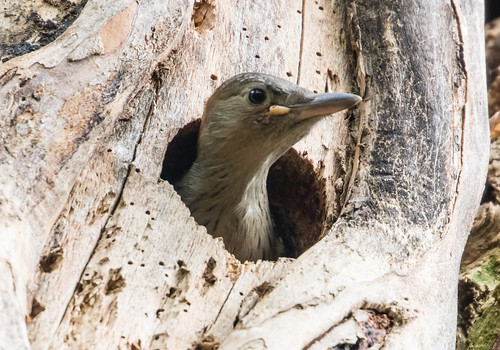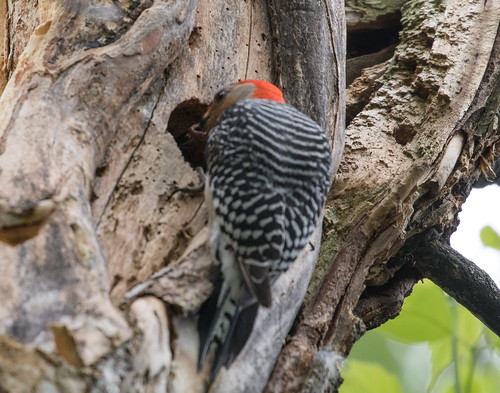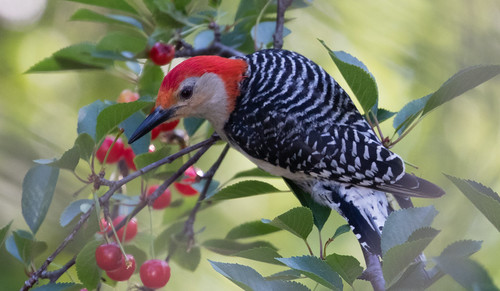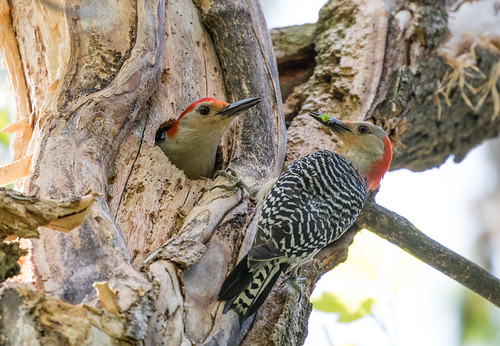The Red-bellied Woodpecker nest in my yard is no longer in use, and I’m not sure what exactly happened.
The first and only day I saw a nestling peeking out the entrance hole was July 8. The chick looked strong and robust, and seemed about ready to fledge.
After the parents fed it, they climbed into the hole and I could hear at least one additional baby being fed, and quite possibly more.


The next morning, I heard all kinds of unusual sounds in my yard, and when I ran out, the parents were dive-bombing crows in the nest tree and the tree next to it. I couldn’t hear any nestlings. I saw three Red-bellieds fly out of the tree. I’m certain two were adults, but didn’t get a good look at the one that followed an adult to the backyard behind mine. I’m hoping against hope that it was the nestling I got photos and video of the day before, having fledged successfully. But I had no idea what was going on with the crows.
Several times that day I saw a parent—sometimes the male and sometimes the female—come to the nest hole with food, and go all the way into the cavity, but each time I heard no baby sounds and the parent ended up flying off with the food. That happened once or twice the next day, too. And then I stopped seeing any Red-bellied Woodpeckers for over a week. Finally, on July 19, I saw an adult male and female and a third bird—I’m not 100 percent certain of its age, but am hopeful I was seeing the family unit. The adults were feeding in Russ’s cherry tree, and a couple of times one flew off with a cherry, which I’m hoping they were bringing to the young one—dense foliage in my other trees made it impossible to know what was going on.

So what happened to the other nestlings? It’s impossible to be certain. The squawking I heard first thing in the morning on the 8th may have been related to the crows—they obviously can’t squeeze into a woodpecker cavity, but could possibly have pulled out a nestling sticking its head out to beg, and possibly could have grabbed a fledgling sitting on a branch. I didn’t hear the noisy sounds a baby crow makes when eating, so I’m at least a little hopeful that the worst-case scenario—one of the babies being ripped apart by a crow—didn’t happen. But I’m pretty sure that not more than one young chick successfully fledged, and I’m afraid something bad happened to the other chicks in the nest. In just about all my photos and videos of the nest, at least one fly is wandering about near the entrance—it’s quite possible most of the babies were harboring botfly larvae—a horrible way for a tiny bird to die.
The box elder tree with the nest lost a limb on one side of the cavity a few weeks ago. On July 21, another storm hit, knocking down a big spruce tree in the yard and ripping off the limb on the other side of the woodpecker cavity in the box elder, but oddly enough, the actual nest cavity may still be intact. When we hire a tree service to deal with a few damaged trees from the big storm, we’ll be removing that section of the box elder’s trunk, and will slice it open to see what the inside looks like. It’s a sad ending to my Red-bellied Woodpecker nesting saga, but even one little baby successfully fledging is a pretty thrilling outcome. It drives home an essential truth—so many things can go wrong when a pair of birds sets out to build a nest, produce and care for eggs, and tend to the chicks, yet every bird on the planet survived that entire process. Each living bird really is a miracle.

Laura Erickson
Laura Erickson, 2014 recipient of the American Birding Association’s prestigious Roger Tory Peterson Award, has been a scientist, teacher, writer, wildlife rehabilitator, professional blogger, public speaker, photographer, American Robin and Whooping Crane Expert for the popular Journey North educational website, and Science Editor at the Cornell Lab of Ornithology. She’s written eight books about birds, including the best-selling Into the Nest: Intimate Views of the Courting, Parenting, and Family Lives of Familiar Birds (co-authored by photographer Marie Read); the National Outdoor Book Award winning Sharing the Wonder of Birds with Kids; 101 Ways to Help Birds; The Bird Watching Answer Book for the Cornell Lab of Ornithology; and the National Geographic Pocket Guide to Birds of North America. She’s currently a columnist and contributing editor for BirdWatching magazine, and is writing a field guide to the birds of Minnesota for the American Birding Association. Since 1986 she has been producing the long-running “For the Birds” radio program for many public radio stations; the program is podcast on iTunes. She lives in Duluth, Minnesota, with her husband, mother-in-law, licensed education Eastern Screech-Owl Archimedes, two indoor cats, and her little birding dog Pip.
Leave a Reply